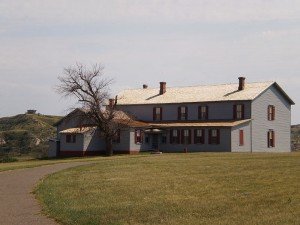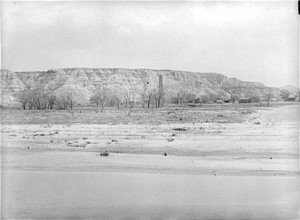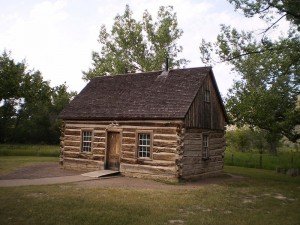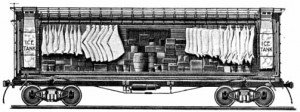Medora is known as a very popular stop for those on a western vacation to North Dakota. The Dakota Badlands area is a beautiful part of the country and attracts thousands of tourists annually. There are many other reasons why Medora North Dakota is a popular stop, one of which is that Teddy Roosevelt ranched in the area during the 1880’s and 90’s. Medora commemorates Roosevelt’s time in the Badlands and the western frontier in general with their hugely popular Medora Musical performed every summer in their 2,500+ seat Burning Hills Amphitheatre. Another reason is to visit the Chateau de Mores which was built by a French nobleman rancher in the early 1880’s.

Among other excellent vacation stops you’ll want to add to your Medora North Dakota vacation planner are the Chateau de Mores Museum, the Theodore Roosevelt National Park, the Medora Riding Stables with trail rides and the buggy rides offered behind the Medora Community Center.
There’s a very interesting story that took place in Medora during the 1880’s which will forever stay a part of the town’s western heritage. This is the story of the Marquis de Mores, a man whose life, achievements, failures and death probably will never be completely understood. The Marquis was a nobleman from France, with a questionable financial status, who made his way across the Atlantic to the wild west of the 1880’s in the Dakota Badlands. This alone wasn’t altogether strange. Many Europeans invested in the American ranching industry in the 1880’s. Most were from Great Britain and an excellent example was the famed XIT Ranch in the Texas Panhandle. Theses investors were really absentee owners of which some occasionally visited the asset. What was a bit strange about the Marquis’ presence in the Medora Dakota Badlands was that he actually was operating a ranch.
The background of the Marquis de Mores is so strange that it really has to be true. Here was a man educated at St Cyr, the prestigious military academy in France that included among it’s graduates, Philippe Petain, famous French general in World War One and figurehead of Vichy France during World War Two. Among other things, in France, the Marquis was a cavalry officer and a famous duelist. All of a sudden the Marquis quit the French cavalry. married a wealthy New York debutant and moved to the Badlands in Dakota Territory.
The Marquis de Mores was a nobleman of questionable wealth although he did spend. His marrying the daughter of a New York banking millionaire certainly didn’t hurt. In fact, the town of Medora was named by the Marquis for his wife, the former Medora Von Hoffman.
Marquis de Mores built a meat packing plant and a twenty-six room house named the Chateau de Mores which serves today as an excellent museum. The biggest story of the Marquis in the Badlands was his idea of a meat processing and packing plant. It was a first in Dakota and in the plains. Thanks to loans from his wealthy father in-law in addition to whatever money he had, the Marquis moved to set up his unique operation which in essence would change the ranching industry in a significant way. The marquis actually built his first operation in Little Missouri across from present day Medora. He or his personality ran into trouble in Little Missouri and as an act of revenge he moved across the river and named the town Medora. The new Medora would prosper as such that many people in Little Missouri also moved across the river.

At the time, meat packing for beef cattle took place in large cities such as Chicago and Kansas City. To be sure, it was a novel idea. Instead of driving cattle to the rail heads for shipment east, the Marquis de Mores would send it east in the new refrigerator rail cars recently developed by Chicago meat processor Gustavus Swift. Interestingly, the railroads paid little attention to Swift since they already had invested big money in stock hauling cars and were satisfied with that method. Swift did get the operation rolling about 1880 when he added about two hundred of these cars and was shipping thousands of carcasses east from Chicago.
In regards to the Marquis, he constructed a meat-packing plant, bought cattle and land, and employed cowboys and meat processing workers. He made an arrangement with the Northern Pacific Railroad to have a transportation line built to Medora. During his first three years, the Marquis de Mores added businesses in Medora, built houses and even founded a Catholic Church. He was a big employer. He also operated the Medora-Deadwood Stagecoach line. The Marquis had a famous friend and neighbor, Theodore Roosevelt, who founded two ranches, one the famous Maltese Cross Ranch, near Medora and enjoyed working in the rugged outdoors.

The meat packing operation worked out quite well at first but then all went bad in 1886. This was all within three years. Some historians contend that the real cause of the bankruptcy was the severe drought of 1886 and the fraction of available livestock because of it. Many ranchers ran into financial trouble during this period. The second reason often attributed by some for the failure was the Marquis himself. He really was an absentee owner since he traveled frequently and spent a lot of money in every respect. The problem was that most of the money in his meat and ranching operations was other peoples money, namely his in-laws. He didn’t have the personal money needed to spend the way he did.
So, what became of the French nobleman who tried his luck in American ranching and meat packing? Most written history of the Marquis will have him returning to France, joining it’s army and then moving to it’s colony in Vietnam to build a railroad. In the middle of the railroad project, leaders changed in France and the new administration halted the Vietnam railroad program. The Marquis reportedly returned to France, got involved in political disputes with the rulers of the day and ended up in Algiers helping France keep the British in Africa in check.

Marquis de Mores, the Badlands Dakota cattle rancher, meat packer, philanthropist met his end in Africa under circumstances not everyone agrees on. His caravan was infiltrated with anti-French natives and the marquis was shot to death. There were people who also pointed a finger at the French government. Some, including the Marquis’ wife, contended that people in the French government who disliked the Marquis intensely were behind his killing.
The story of the Marquis de Mores is a story about Medora North Dakota. It’s about a Frenchman who immersed himself in the American ranching business, founded an historic town in 1880’s Dakota Territory which today, in the twenty-first century, is a highly popular tourist destination and home to the Theodore Roosevelt National Park. All of this was created by a graduate of St. Cyr miltary school in France who chased his American dream as a rancher and meat packer, moved to Vietnam and then met his end in a caravan in Africa under suspicious circumstances. It’s a story too amazing not to be true.
You will also find interesting our Trips Into History article on Roosevelt’s Maltese Cross Ranch and on our Western Trips site the story about the historic XIT Ranch in Texas.
Some good books regarding cattle ranching, the Marquis and the Dakota Badlands are The Cattle Kings by author Lewis Atherton, Marquis de Mores: Emperor of the Badlands by author Donald Dresden and Medora and Theodore Roosevelt National Park by author Gary Leppart.
(California State Museum refrigerator car photo from author’s private collection. Remaining photos and images are in the public domain)

